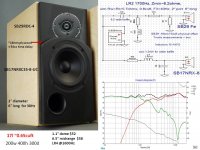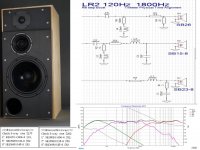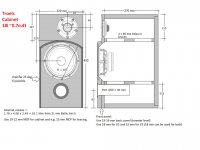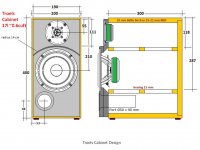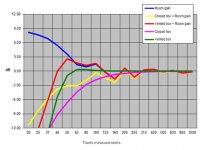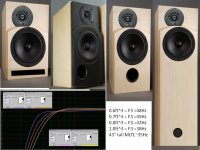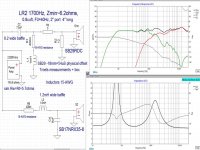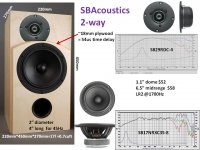Hey guys,
first of all: This is my first post here, so sorry if I make any mistakes!
I've decided to build myself new desktop speakers, but I don't know which design is best for my needs. It should cover the following points:
1. Max. budget is 600€. Less is very welcome 🙂
2. No rear-facing bass reflex openings since I have to place the speakers in corners...
3. I'm living in a really small room (ca. 3x6m) so they should not be too big
4. I like a strong bass, but also mids and highs should be powerfull. However, they should not blow away my neighbours ears 😉
5. I have an old amp from my JVC UX-g950v (160W) + an old receiver with a 170W AMP. So the speakers could be passive 🙂 (If I'm wrong with that just let me know ^^)
I'd appreciate any input on what designs would work best or in general on audio, since I'm new to this section 🙂
Already a huge thank you 🙂
first of all: This is my first post here, so sorry if I make any mistakes!
I've decided to build myself new desktop speakers, but I don't know which design is best for my needs. It should cover the following points:
1. Max. budget is 600€. Less is very welcome 🙂
2. No rear-facing bass reflex openings since I have to place the speakers in corners...
3. I'm living in a really small room (ca. 3x6m) so they should not be too big
4. I like a strong bass, but also mids and highs should be powerfull. However, they should not blow away my neighbours ears 😉
5. I have an old amp from my JVC UX-g950v (160W) + an old receiver with a 170W AMP. So the speakers could be passive 🙂 (If I'm wrong with that just let me know ^^)
I'd appreciate any input on what designs would work best or in general on audio, since I'm new to this section 🙂
Already a huge thank you 🙂
Hi,
For a compact bookshelf for the desktop you can take a look at this design:
https://sites.google.com/site/undefinition/speedster
The standard plans come with a round port at the back - however there is a slot ported version too - maybe you can drop Paul Carmody a mail once you are decided. Here's one build thread with the slot port:
Paul Carmody's Speedster Build Thread with a Twist - Techtalk Speaker Building, Audio, Video Discussion Forum
For a compact bookshelf for the desktop you can take a look at this design:
https://sites.google.com/site/undefinition/speedster
The standard plans come with a round port at the back - however there is a slot ported version too - maybe you can drop Paul Carmody a mail once you are decided. Here's one build thread with the slot port:
Paul Carmody's Speedster Build Thread with a Twist - Techtalk Speaker Building, Audio, Video Discussion Forum
Hey
whatever design / speaker you pick i suggest that you make sure there is a gentle bass roll of starting at 150Hz. Your speaker placement will result in a hefty increase of bass (corner) and reflection fr8m the desk top increases frequncy response around 150 Hz.
If the design has a rear fireing port you can try lengthening the br port and placing it on the side or top of the cabinet.
Regards
whatever design / speaker you pick i suggest that you make sure there is a gentle bass roll of starting at 150Hz. Your speaker placement will result in a hefty increase of bass (corner) and reflection fr8m the desk top increases frequncy response around 150 Hz.
If the design has a rear fireing port you can try lengthening the br port and placing it on the side or top of the cabinet.
Regards
FIRST LEVEL: What woodshop tools and talent do you have?
SECOND LEVEL: Decide upon 2-way vs. 3-way, AND largest acceptable box size.
Your budget will allow you to build a 2-way with "premium" drivers and crossover parts, or a 3-way with "high value" drivers+crossover.
===========
Look over the 2-way box size(W200xH400xD300) used by Troels. (1" dome + 6" midbass)
SBAcoustics-61-NRXC
Look over the 3-way box size(W280xH600xD340) used by Troels. (1" dome) & (4" or 5" midrange) & (ported 8" woofer)
Using SB_Acoustics drivers will meet your budget.
SBAcoustics-3WC
SEAS-3-Way-Classic-mkII
For greater 3-way dynamics, you can use a 6" midrange.
==========
For more powerful 3-way bass you can use two 8" woofers in side-side low-vibration cabinets.
"Kii style" cabinet is attractive and well designed. 700€
SECOND LEVEL: Decide upon 2-way vs. 3-way, AND largest acceptable box size.
Your budget will allow you to build a 2-way with "premium" drivers and crossover parts, or a 3-way with "high value" drivers+crossover.
===========
Look over the 2-way box size(W200xH400xD300) used by Troels. (1" dome + 6" midbass)
SBAcoustics-61-NRXC
Look over the 3-way box size(W280xH600xD340) used by Troels. (1" dome) & (4" or 5" midrange) & (ported 8" woofer)
Using SB_Acoustics drivers will meet your budget.
SBAcoustics-3WC
SEAS-3-Way-Classic-mkII
For greater 3-way dynamics, you can use a 6" midrange.
==========
For more powerful 3-way bass you can use two 8" woofers in side-side low-vibration cabinets.
"Kii style" cabinet is attractive and well designed. 700€
Attachments
FIRST LEVEL: What woodshop tools and talent do you have?
SECOND LEVEL: Decide upon 2-way vs. 3-way, AND largest acceptable box size.
Your budget will allow you to build a 2-way with "premium" drivers and crossover parts, or a 3-way with "high value" drivers+crossover.
===========
Look over the 2-way box size(W200xH400xD300) used by Troels. (1" dome + 6" midbass)
SBAcoustics-61-NRXC
Look over the 3-way box size(W280xH600xD340) used by Troels. (1" dome) & (4" or 5" midrange) & (ported 8" woofer)
Using SB_Acoustics drivers will meet your budget.
SBAcoustics-3WC
SEAS-3-Way-Classic-mkII
For greater 3-way dynamics, you can use a 6" midrange.
==========
For more powerful 3-way bass you can use two 8" woofers in side-side low-vibration cabinets.
"Kii style" cabinet is attractive and well designed. 700€
Thanks for your answer 🙂
I have basic tools like a table saw and so on. As for talents: I would not say I am really good, but nether bad. However, I know some people that are really good at woodwork, so I might find some help there.
I don't really know what benefits each type of speaker would give, since I am new to audio and hifi. I just want what gives me the best for my money (and it should not be too hard to assemble, I never did sth like that before).
Largest box size would be around 23cmx40cmx22cm. But that would use almost my whole desk 😉 So I guess a 2-way speaker would be better as they tend to be smaller? Also I am sitting just 1m away from both speakers, maybe that's an useful information 😀
Also I have a general question about building speakers: Is it hard to build a crossover for the first time? Or is it better buying a pre-built crossover? Or maybe even a whole kit for the speakers?
EDIT: I could not read through all of the designs because I'm busy today, so sorry if some questions are stupid 😀
Last edited:
For your goals, a 2-way speaker using a 6" midbass in a ported cabinet is a good first design to consider. A 17liter - 18liter box can generate good bass, and you can build smaller boxes with less bass extension if necessary. Room gain from near wall, and near floor/desktop placement can increase bass SPL. Troels website has detailed cabinet construction information. It is common to use perforated hardboard (peg board) to mount the passive components, and common to solder the connections. There are screw-down connectors (cylinder with screw) which can also be used, and electrical twist-connectors are another option.
A web search for the SB_Acoustics SB17NRXC35-8 midbass and SB29RDC-4 tweeter will produce several alternative designs you can compare.
https://www.lautsprecherbau.de/Maga...ne-2012/April-2012/_SB-18_8636,en,900970,4088
https://www.loudspeakerbuilding.com/
Germany has several recommended speaker shops.
Compagnie Acoustique de Belgique, Compacbel
A web search for the SB_Acoustics SB17NRXC35-8 midbass and SB29RDC-4 tweeter will produce several alternative designs you can compare.
https://www.lautsprecherbau.de/Maga...ne-2012/April-2012/_SB-18_8636,en,900970,4088
https://www.loudspeakerbuilding.com/
Germany has several recommended speaker shops.
Compagnie Acoustique de Belgique, Compacbel
Attachments
Thanks for your answer 🙂
I don't really know what benefits each type of speaker would give, since I am new to audio and hifi. I just want what gives me the best for my money (and it should not be too hard to assemble, I never did sth like that before).
Largest box size would be around 23cmx40cmx22cm. But that would use almost my whole desk 😉 So I guess a 2-way speaker would be better as they tend to be smaller? Also I am sitting just 1m away from both speakers, maybe that's an useful information 😀
Also I have a general question about building speakers: Is it hard to build a crossover for the first time? Or is it better buying a pre-built crossover? Or maybe even a whole kit for the speakers?
You only need basic soldering skills to build a crossover. And maybe some insight in component placement - when coils are placed near each other, they tend to interact. But surely there'll be someone willing to give you little advice on the crossover layout. It's really not that hard. Might seem a bit daunting at first if you've zero electronics experience, but once you get over it, you'll be surprised at how easy it is.
But that's assuming you're working from some established design. Crossover design isn't exactly rocket science, but it does require considerable knowledge and experience.
Since you're listening in the nearfield, I'd consider a basic 2-way, maybe even a just a single fullrange driver. The more you have drivers the more distance you need between the speakers and listening spot for all the drivers to 'integrate' (ie. not sound separate from each other).
One good solution would be to use a coaxial driver; since both drivers radiate from the same spot, they need virtually no distance between speaker and listening spot to integrate. I'm using a pair of 18Sound 8CX401's on my desk, and they're quite nice. The well known Seas 6,5" coaxes would go further down low, but the 18Sounds give a more lively, punchy and vivid presentation. You should be able to acquire either pair plus crossover components under your budget limit.
Desktop speakers. Here FRs have a big advantage because the mid and top are not physically separated., and given a penchant for bass, and a small room a couple of (small) subs for support (to make a 2-way). 2 separate as a small room will have higher frequency modes and being able to move 2 or mre woofers around is th ebest way to deal with that.
Speakers & [plate amps for the subs should be doable within your budget.
Speakers & [plate amps for the subs should be doable within your budget.
^ what planet10 said.
From there it's down to selecting the Fullrange (and its *enclosure).
Then contemplate the subwoofer driver(s), its enclosure(s), and the amplifiers.
*I'd probably try an "Ikea Salad bowl" enclosure (back-to-back bowls) to achieve that sort of spherical shape.
You could linearize the result (at your listening position) with just a standard miniDSP + UMIK1.
L&R for Fullrange and L&R for Subwoofers.
miniDSP Kits: miniDSP 2x4 kit
From there it's down to selecting the Fullrange (and its *enclosure).
Then contemplate the subwoofer driver(s), its enclosure(s), and the amplifiers.
*I'd probably try an "Ikea Salad bowl" enclosure (back-to-back bowls) to achieve that sort of spherical shape.
You could linearize the result (at your listening position) with just a standard miniDSP + UMIK1.
L&R for Fullrange and L&R for Subwoofers.
miniDSP Kits: miniDSP 2x4 kit
Last edited:
I'm another full-range fan for near field listening. I've tried a few different configurations and my favorite is a pair of CHP-70 sim golden ratio speakers. The bass and imaging were outstanding. Don't let the low price lead you to believe they can't sound good.
Markaudio CHP-70 Gen2 Natural Paper
http://frugal-phile.com/boxlib/P10free/CGR-dKal-El703-301113.pdf
Markaudio CHP-70 Gen2 Natural Paper
http://frugal-phile.com/boxlib/P10free/CGR-dKal-El703-301113.pdf
Do note that the CHP70 has a purposely shelved down top2 octaves. Some find that problematic, but it is quite good everywhere else.
I do have one set of EnABLed ones left.
dave
I do have one set of EnABLed ones left.
dave
Do you guys realize this thread was necro'ed by someone asking about a particular coax' crossover ? What's the point bringing in fullranges ?
I missed the age and comment of what the OP decided. I was simply offering my thoughts in hopes of helping someone with a decision. Had I realized my error, I would have kept scrollling. If I've caused anyone any distress, I apologize.
- Home
- Loudspeakers
- Multi-Way
- DIY Desktop speaker design (max. 600€)
